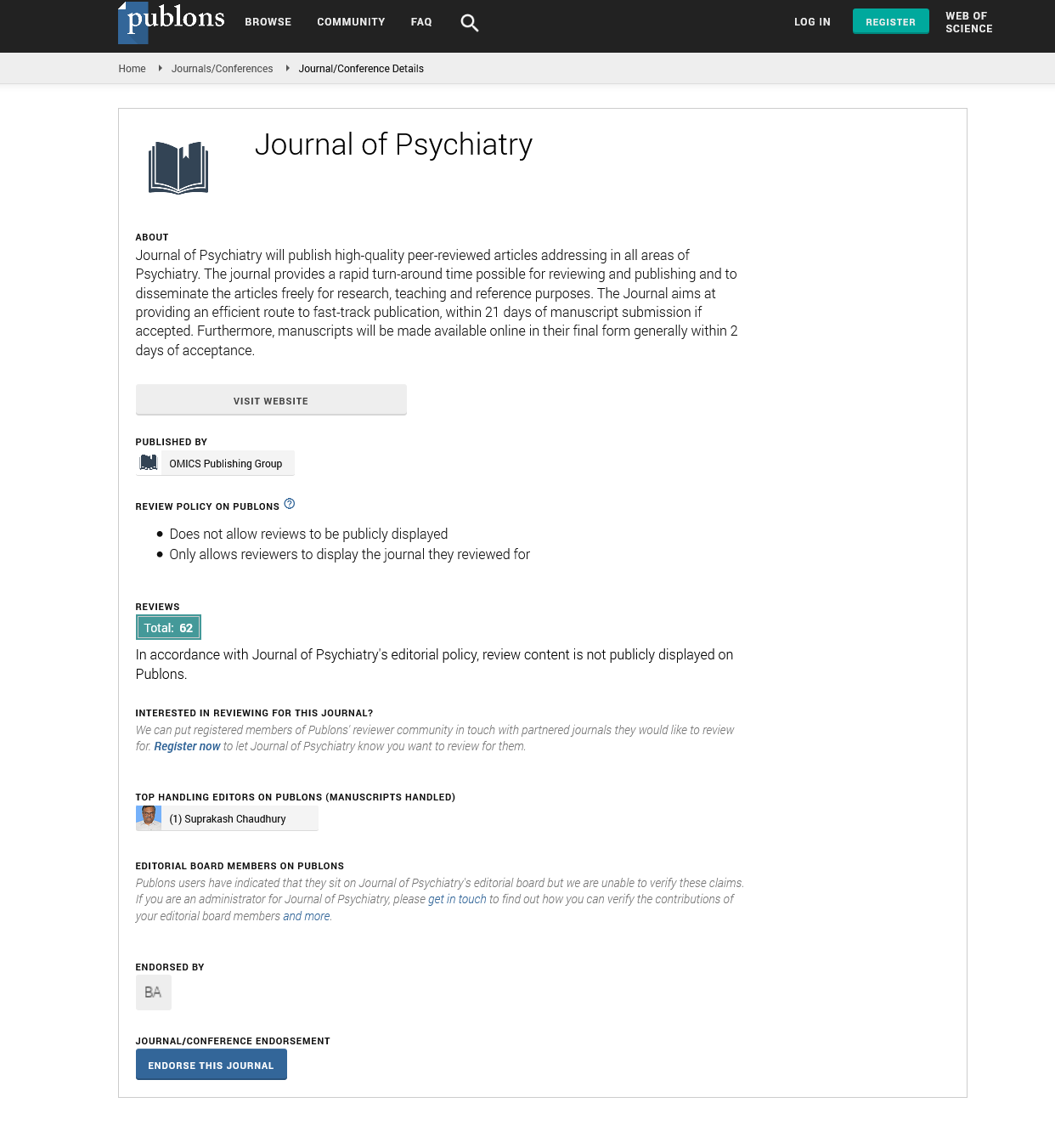Indexed In
- RefSeek
- Hamdard University
- EBSCO A-Z
- OCLC- WorldCat
- SWB online catalog
- Publons
- International committee of medical journals editors (ICMJE)
- Geneva Foundation for Medical Education and Research
Useful Links
Share This Page
Open Access Journals
- Agri and Aquaculture
- Biochemistry
- Bioinformatics & Systems Biology
- Business & Management
- Chemistry
- Clinical Sciences
- Engineering
- Food & Nutrition
- General Science
- Genetics & Molecular Biology
- Immunology & Microbiology
- Medical Sciences
- Neuroscience & Psychology
- Nursing & Health Care
- Pharmaceutical Sciences
Perspective - (2024) Volume 27, Issue 3
Risk Patterns and Strategies for Substance-Triggered Mental Disturbance in Adolescents
Jillian Amlung*Received: 03-May-2024, Manuscript No. JOP-24-25835; Editor assigned: 06-May-2024, Pre QC No. JOP-24-25835 (PQ); Reviewed: 20-May-2024, QC No. JOP-24-25835; Revised: 27-May-2024, Manuscript No. JOP-24-25835 (R); Published: 03-Jun-2024, DOI: 10.35248/2378-5756.24.27.691
Description
Substance use among adolescents is a complex issue with significant implications for mental health. While experimentation with drugs and alcohol is common during adolescence, some individuals may experience substance- triggered mental disturbances, such as psychosis, mood disorders, or anxiety. This examines the risk patterns associated with substance-triggered mental disturbances in adolescents and explores strategies for prevention, early intervention, and treatment. Substance-triggered mental disturbances refer to the acute or chronic onset of psychiatric symptoms following substance use. Adolescents are particularly vulnerable to these disturbances due to ongoing brain development, heightened susceptibility to peer influences, and exploration of identity and risk-taking behaviors. Common substances associated with mental disturbances in adolescents include alcohol, cannabis, stimulants, hallucinogens, and synthetic drugs.
Risk patterns
Several risk patterns contribute to the development of substance- triggered mental disturbances in adolescents.
• Adolescents who initiate substance use at an early age are at increased risk of developing mental disturbances due to the potential impact on brain development and cognitive functioning.
• The concurrent use of multiple substances, known as polydrug use, is prevalent among adolescents and can increase the likelihood of adverse mental health outcomes.
• Adolescents with pre-existing mental health conditions, such as depression, anxiety, or trauma-related disorders, are more susceptible to substance-triggered mental disturbances.
• Genetic factors play a significant role in individual susceptibility to substance-induced psychiatric symptoms, with certain genetic variations increasing the risk of adverse reactions to specific substances.
• Environmental factors, including peer pressure, family history of substance abuse, socioeconomic status, and exposure to trauma or adverse childhood experiences, contribute to the risk of substance-triggered mental disturbances.
Intervention strategies
Prevention, early intervention, and treatment strategies are essential for addressing substance-triggered mental disturbances in adolescents
Prevention programs: School-based prevention programs, community outreach initiatives, and public health campaigns play an important role in preventing substance use initiation and reducing risk factors associated with mental disturbances. These programs focus on education, skill-building, and encouraging positive peer relationships to promote healthy decision-making and resilience.
Screening and assessment: Routine screening for substance use and mental health issues is essential in primary care settings, schools, and juvenile justice systems to identify at-risk adolescents and intervene early. Screening tools, such as the CRAFFT (Car, Relax, Alone, Forget, Friends, Trouble) questionnaire, can help identify adolescents with substance use disorders and mental health concerns.
Psychoeducation and counseling: Providing adolescents and their families with psychoeducation about the risks of substance use and mental disturbances can increase awareness and promote informed decision-making. Counseling interventions, such as Cognitive-Behavioral Therapy (CBT), Motivational Interviewing (MI), and family therapy, can help adolescents develop coping skills, enhance problem-solving abilities, and address underlying emotional issues.
Harm reduction strategies: Harm reduction approaches, such as needle exchange programs, safe injection sites, and overdose prevention education, aim to reduce the negative consequences associated with substance use without requiring abstinence.
These strategies prioritize safety, health promotion, and respect for individual autonomy, particularly for adolescents who may not be ready or willing to abstain from substance use.
Integrated treatment: Adolescents with co-occurring substance use and mental health disorders benefit from integrated treatment approaches that address both the conditions concurrently. Integrated treatment programs provide comprehensive assessment, individualized treatment planning, and coordinated care across multiple service systems, including mental health, substance abuse, education, and social services.
Pharmacotherapy: In some cases, pharmacotherapy may be indicated for adolescents with substance-triggered mental disturbances, particularly those with severe symptoms or co- occurring psychiatric disorders. Medications, such as antipsychotics, mood stabilizers, or antidepressants, may help alleviate acute symptoms and stabilize mood, but should be used judiciously and under close medical supervision.
Substance-triggered mental disturbances pose significant risks to adolescent health and well-being, requiring a comprehensive and multidisciplinary approach to prevention, early intervention, and treatment. By understanding the risk patterns associated with substance use and mental health in adolescents and implementing evidence-based strategies, clinicians, educators, policymakers, and community stakeholders can mitigate the impact of substance-triggered mental disturbances and promote positive outcomes for adolescents in need of support. Efforts to address substance use and mental health concerns in adolescents should prioritize prevention, early identification, and access to integrated treatment services to ensure that adolescents receive the care and support they need to thrive.
Citation: Amlung J (2024) Risk Patterns and Strategies for Substance-Triggered Mental Disturbance in Adolescent. J Psychiatry. 27:691.
Copyright: © 2024 Amlung J. This is an open access article distributed under the terms of the Creative Commons Attribution License, which permits unrestricted use, distribution, and reproduction in any medium, provided the original author and source are credited.

